Deep Sea Fishing Species
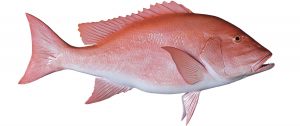
American Red Snapper
The northern red snapper’s body is very similar in shape to other snappers, such as the mangrove snapper, mutton snapper, lane snapper, and dog snapper. All feature a sloped profile, medium-to-large scales, a spiny dorsal fin, and a laterally compressed body.
This snapper reaches maturity at a length of about 39 cm (15 in). The common adult length is 60 cm (24 in), but may reach 100 cm (39 in). The maximum published weight is 38 kg (84 lb),[3] and the oldest reported age is 100+ years.[2]
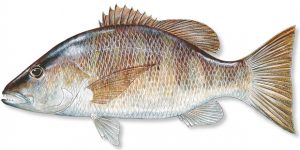
Mangrove Snapper
Its color is typically greyish red, but it can change color from bright red to copper red. It has a dark stripe running across its eye if observed from the top when it is under water. This species can reach a length of 89 cm (35 in), though most do not exceed 40 cm (16 in). The greatest recorded weight for this species is 20 kg (44 lb).[2]
The mangrove snapper can be confused with the Cubera snapper or black snapper, Lutjanus cyanopterus. Mangrove snapper are typically much smaller than Cubera, but when they are of similar size, the two species can only be distinguished by examining the tooth patch on the inside roof of the mouth. Many specimens caught in Florida, specifically Punta Gorda, are actually misidentified dogtooth or dog snapper, Lutjanus jocu.
The best way to distinguish between the two species is dog snapper has a lighter triangle of color with a blue band under the eye and large, sharp fangs in the front (canines), hence its common name. These fangs can deliver a painful bite, even in a small fish. The mangrove snapper feeds mostly on small fishes and crustaceans. It was also observed as systematically waiting under maternal colony of Buffy flower bat for falling bats near the entrances of Lucayan cavern, Bahamas.[3]
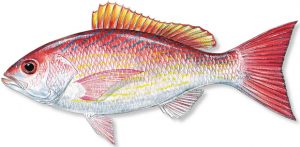
Vermillion Snapper
The vermilion snapper or beeliner (Rhomboplites aurorubens) is a species of snapper native to the western Atlantic Ocean from North Carolina to Bermuda including the Gulf of Mexico and the Caribbean Sea to Brazil. This species inhabits waters from 40 to 300 m (130 to 980 ft) (though rarer deeper than 100 m (330 ft)) where they can be found in large schools over substrates of sand, gravel, or rock. This species can reach a length of 60 cm (24 in), though most are around 35 cm (14 in). The greatest recorded weight for this species is 3.2 kg (7.1 lb). It is of minor importance to local commercial fisheries.[1] The vermilion snapper is often sold as red snapper.[2]
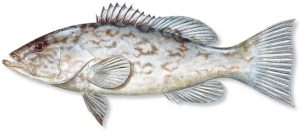
Gag Grouper
Mycteroperca microlepis (the gag, gag grouper, velvet rockfish or charcoal belly) is a species of grouper from warmer parts of the West Atlantic, including the Caribbean and Gulf of Mexico. It is a drab, mottled-gray fish lacking the distinguishing features of most other groupers. Its pattern of markings resemble the box-shaped spots of the black grouper. It lacks the streamer-points on the tail fin that scamp (Mycteroperca phenax) and yellowmouth grouper (M. interstitialis) have, and lacks yellow coloration around the mouth.
Ten- to 20-pound (5- to 10-kg) fish are common. The world record is 80 lb 6 oz (36.45 kg). The gag grouper is a bottomfeeder and is often caught by fishermen seeking bottom-dwelling species, such as snappers. Its flaky white meat is considered quite delicious.
Members of this species are known to be protogynous hermaphrodites, schooling in harems with the most aggressive and largest females shifting sex to male, probably as a result of behavioral triggers, when no male is available. Commercial and sport fishing have created tremendous selective pressures against the largest animals, typically male, restricting the reproductive capacity of the entire breeding population.
Recently, a small closure in the Gulf of Mexico was established to provide this and other species a refuge from commercial fishing pressure, however, these data are highly in dispute and are currently being challenged for inaccuracies. They are found in areas of hard or consolidated substrate, and use structural features, such as ledges, rocks, and coral reefs (as well as artificial reefs, such as wrecks and sunken barges) as their habitats.

Red Grouper
The red grouper (Epinephelus morio) is a species of fish in the Family Serranidae. The red grouper’s typical range is coastal areas in the western Atlantic, stretching from southern Brazil to North Carolina in the US and including the Gulf of Mexico.[1] This demersal, largely sedentary species has an extended (~40 day) pelagic larval stage before it settles in shallow coastal hardbottom habitat as juveniles.
They remain in inshore waters for 4–5 years before migrating to offshore hardbottom habitat—particularly on the edge of the continental self—as adults. Spawning occurs offshore between January and June, peaking in May. While primarily eating benthic invertebrates, the red grouper is an opportunistic feeder in the reef community. The diet commonly includes xanthid and portunid crabs, juvenile spiny lobster, and snapping shrimp, with the occasional fish.
The red grouper is of moderate size, about 125 cm and weighs 23 kg or more. Body coloration is typically reddish-brown in color often, with many white spots. When aggravated (they are highly territorial) or involved in spawning activities, these fish can very rapidly change coloration patterns, with the head or other parts of the body turning completely white, and the white spots appearing more intense.
Habitat Engineers of the Sea
Red grouper actively excavate pits in the seafloor. They start digging in the sediment from the time they settle out of the plankton and continue throughout their lifetime. They use their caudal fin and their mouths to remove debris and sediment from rocks, creating exposed surfaces on which sessile organisms actively settle (e.g., sponges, soft corals, algae). The exposure of structure also attracts a myriad of other species, including mobile invertebrates and a remarkable diversity of other fishes, from gobies and butterflyfish to grunts and snapper. The lionfish Pterois volitans started invading red grouper habitat by 2008, from Florida Bay to the Florida Keys and offshore to Pulley Ridge, a mesophotic coral reef on the West Florida Shelf west of the Dry Tortugas. Known for being extremely capable predators on small reef fish, scientists are very interested in determining the extent to which their invasion changes the functional dynamics of associated communities.
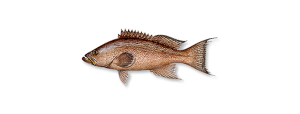
Scamp Grouper
The scamp grouper (Mycteroperca phenax) is a protogynous grouper also known as the brown grouper or abadejo. It is normally found in reef over ledges and high-relief rocky bottoms in the eastern Gulf of Mexico and at low-profile bottoms at depths of 30 to 100 m in North Carolina. Juveniles can be found as far north as Massachusetts in shallow water at jetties and mangrove areas. This species was the most abundant grouper in areas of living Oculina coral formations at depths of 70 to 100m off the east coast of Florida. The scamp grouper apparently moves inshore when bottom temperature falls below 8.6 °C. Commonly, the scamp is about 30 cm long, which makes it a relatively small member of the groupers, but a specimen has been reported at 107 cm.[2]
The fish’s overall coloration is a deep tan or chocolate brown, with numerous darker markings that form dots, or lines, or groups of lines.[3]
Fishing
The scamp is a popular game and commercial fish and is high prized among the grouper family. Its meat is white in color, sweet in taste and has excellent food value.[3]
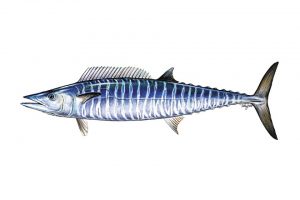
Wahoo
Wahoo (Acanthocybium solandri) is a scombrid fish found worldwide in tropical and subtropical seas. It is best known to sports fishermen, as its speed and high-quality flesh make it a prize game fish. In Hawaii, the wahoo is known as ono.[4]
The flesh of the wahoo is white to grey, delicate to dense, and highly regarded by many gourmets. This has created some demand for the wahoo as a premium-priced commercial food fish. In many areas of its range, such as Hawaii, Bermuda and many parts of the Caribbean, local demand for wahoo is met by artisanal commercial fishermen, who take them primarily by trolling, as well as by recreational sports fishermen who sell their catch.

King Mackerel
The king mackerel or kingfish (Scomberomorus cavalla) is a migratory species of mackerel of the western Atlantic Ocean and Gulf of Mexico. It is an important species to both the commercial and recreational fishing industries.
King mackerel are among the most sought-after gamefish throughout their range from North Carolina to Texas. Known throughout the sportfishing world for their blistering runs, the king mackerel matches its distant relative, the wahoo, in speed.
They are taken mostly by trolling, using various live and dead baitfish, spoons, jigs and other artificial lures. Commercial gear consists of run-around gill nets. They are also taken commercially by trolling with large planers, heavy tackle and lures similar to those used by sport fishers.
Typically when using live bait, two hooks are tied to a strong metal leader. The first may be a treble or single and is hooked through the live bait’s nose and/or mouth. The second hook (treble hook) is placed through the top of the fish’s back or allowed to swing free.
This must be done because king mackerel commonly bite the tail section of a bait fish. When trolling for kings using this method, it is important to make sure the baitfish are swimming properly. Typical tackle includes a conventional or spinning reel capable of holding 340 m (370 yd) of 13 kg (29 lb) test monofilament and a 2 m (6 ft 7 in), 13 kg (29 lb) class rod.
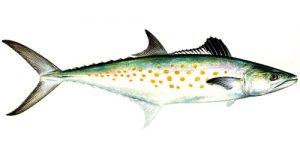
Spanish Mackerel
The Atlantic Spanish mackerel (Scomberomorus maculatus) is a migratory species of mackerels that swims to the Northern Gulf of Mexicoin spring, returns to south Florida in the Eastern Gulf, and to Mexico in the Western Gulf in the fall.
The fish exhibits a green back; its sides are silvery marked with about three rows of round to elliptical yellow spots. Lateral line gradually curving down from the upper end of the gill cover toward caudal peduncle. The first (spiny) dorsal fin is black at the front. Posterior membranes are white with a black edge. Its single row of cutting edged teeth in each jaw (around sixty-four teeth in all) are large, uniform, closely spaced and flattened from side to side. As with the King mackerel and the Cero mackerel, these teeth look very similar to those of the Bluefish, Pomatomus saltatrix.
Spanish mackerel occur seasonally from the Yucatán peninsula, Mexico, as far north as Cape Cod, Massachusetts. They are a shallow water species, preferring sand bottom in depths of 10 to 40 feet (3 to 12 m), occasionally found as deep as 80 feet (24 m).
It appears that one Atlantic and one or more Gulf groups of Spanish mackerel occur in Florida waters. With rising water temperatures, the Atlantic group migrates along the Atlantic coast of the United States from Miami Florida, beginning in late February through July reaching as far as southern Cape Cod, Massachusetts, then returning in fall.
An Eastern Gulf group moves northward from the Florida Keys during late winter and spring, appearing off the central West Coast of Florida about April 1. Movement continues westward and terminates along the northern Texas coast. During fall, this group migrates back to its wintering grounds in the Keys.